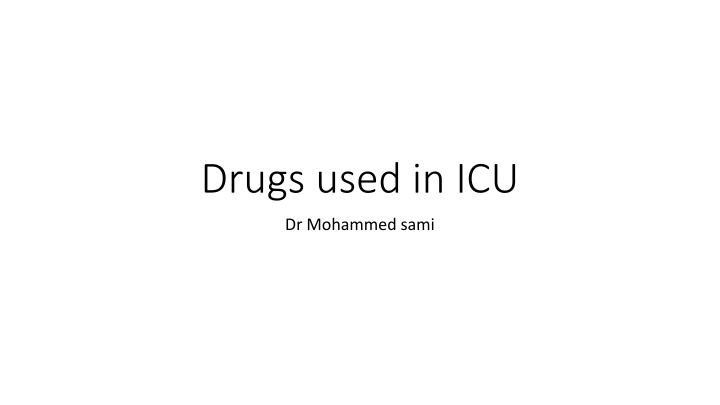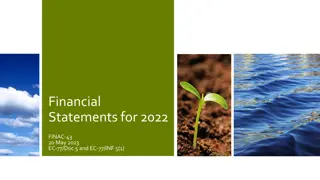
Cardiac Function in Critical Care Settings
Explore the essentials of cardiac function in ICU, including drugs used, cardiac output, preload, contractility, afterload, and adrenergic receptors. Learn how these factors impact patient care and outcomes. Images and detailed explanations provided by Dr. Mohammed Sami.
Download Presentation

Please find below an Image/Link to download the presentation.
The content on the website is provided AS IS for your information and personal use only. It may not be sold, licensed, or shared on other websites without obtaining consent from the author. If you encounter any issues during the download, it is possible that the publisher has removed the file from their server.
You are allowed to download the files provided on this website for personal or commercial use, subject to the condition that they are used lawfully. All files are the property of their respective owners.
The content on the website is provided AS IS for your information and personal use only. It may not be sold, licensed, or shared on other websites without obtaining consent from the author.
E N D
Presentation Transcript
Drugs used in ICU Dr Mohammed sami
Cardiac Output (CO) Cardiac Output (CO) CO =HR X stroke volume (SV) SV: is the amount of blood ejected from the ventricles with each beat average is approx 70mls SV is affected by preload, contractility & afterload
Preload Preload - the stretch of the ventricle at the end of diastole - the amount of stretch = the amount of blood ejected - ventricular myocardium responds by contracting more forcefully
Contractility Contractility - the force of the myocardial contraction for a given preload - affected by: 1- electrolytes Na+, K+, Mg, Ca2+, Ph 2-+ve & -ve inotropes 3- preload & after load 4-affected by oxygenation, areas of damage & disease & ischaemia - Afterload - the resistance of the arteries against ejection - increases cardiac workload
Adrenergic Receptors Adrenergic Receptors Located throughout the body Are receptors for the sympathetic neurotransmitters (alpha)-adrenergic receptors (beta)-adrenergic receptors Dopaminergic receptors: respond only to dopamine
- -Adrenergic Receptors Adrenergic Receptors Divided into 1and 2receptors Differentiated by their location on nerves 1-Adrenergic Receptors Located on postsynaptic effector cells (the cell, muscle, or organ that the nerve stimulates) 2-Adrenergic Receptors Located on presynaptic nerve terminals (the nerve that stimulates the effector cells) Control the release of neurotransmitters
-Adrenergic Receptors All are located on postsynaptic effector cells 1-adrenergic receptors located primarily in the heart 2-adrenergic receptors located in smooth muscle of the bronchioles, arterioles, and visceral organs
Dopaminergic Receptors Dopaminergic Receptors Dopamine receptors Causes dilation of the following blood vessels, resulting in increased blood flow Renal Mesenteric Coronary Cerebral
Responses to Stimulation Responses to Stimulation Receptor Location Response Cardiovascular: Blood vessels 1 Constriction 1 Cardiac muscle Increased contractility 1. Increased heart rate Gastrointestinal: Muscle: Sphincters: 2 1 Decreased motility Constriction
Responses to Stimulation Responses to Stimulation Location Receptor Response Genitourinary: Bladder sphincter 1 Constriction 1 2 Uterus Contraction Relaxation Respiratory: Bronchial muscles 2 Dilation 2 Liver Glycogenolysis 1 Pupils Dilation
Catecholamines Catecholamines Substances that can produce a sympathomimetic response Endogenous Epinephrine, norepinephrine, dopamine Synthetic dobutamine, phenylephrine Mechanism of Action: either Direct-acting sympathomimetic Attach directly to the receptor and causes a physiologic response
Response to Direct Response to Direct- -Acting Sympathomimetics Sympathomimetics Acting
Indirect Indirect- -acting sympathomimetic acting sympathomimetic Indirect-acting sympathomimetic Causes the release of catecholamine from the storage sites (vesicles) in the nerve endings The catecholamine then binds to the receptors and causes a physiologic response
Indirect Indirect- -acting sympathomimetic acting sympathomimetic
Stimulation of Stimulation of - -adrenergic receptors adrenergic receptors Stimulation of -adrenergic receptors on smooth muscles results in: Vasoconstriction of blood vessels Relaxation of GI smooth muscles Contraction of the uterus and bladder Decreased insulin release Contraction of the ciliary muscles of the eye (dilated pupils)
Stimulation of Stimulation of 1 1- -adrenergic receptors adrenergic receptors Stimulation of 1-adrenergic receptors on the myocardium, AV node, and SA node results in cardiac stimulation Increased force of contraction (positive inotropic effect) Increased heart rate (positive chronotropic effect)
Stimulation of Stimulation of 2 2- -adrenergic receptors adrenergic receptors Stimulation of 2-adrenergic receptors on the airways results in: Bronchodilation (relaxation of the bronchi) Uterine relaxation Glycogenolysis in the liver Increased renin secretion in the kidneys
Vasoactive Sympathomimetics Vasoactive Sympathomimetics Pressors, (Inotropes, cardioselective sympathomimetics) dobutamine (Dobutrex) ephedrine fenoldopam (Corlopam) methoxamine Dopamine (Intropin) Epinephrine (Adrenalin) Norepinephrine (Levophed) Phenylephrine (Neo-Synephrine)
Vasopressors & Inotropes Adrenaline Dose : 0.04 1 mcg/kg/minute doses <0.3 mcg/kg/minute produce -adrenergic effects -higher doses (>0.3 mcg/kg/minute) generally produce - vasoconstriction Infusion rate: 5 amp X 50 ml 1 ml =100 mcg doses 1.5-42 ml/hr. (very high doses for refractory hypotension)
ADMINISTRATION ROUTES: ADMINISTRATION ROUTES:- - IV, IM, SC, NEBULISED - Adrenaline is a sympathomimetic drug. It activates an adrenergic receptors. - Adrenaline acts on both alpha and beta receptors. - ICU INDICATIONS:- i- Cardiac arrest ii- Anaphylaxis iii- Upper airway obstruction iv- Inotrope / vasopressor
- Adrenaline comes in vials containing 1mg in 1ml (1:1000) - Store at room temperature. Protect from light. - Do not refrigerate. - Solutions that are discolored pink or brown should not be used.
Effects Cardiovascular vary according to dose. -low-dose infusion, effects. This produces an increase in cardiac output, myocardial oxygen consumption, coronary artery dilatation and reduces the threshold for arrhythmias. high doses by infusion or when given as a 1 mg bolus during cardiac arrest, 1 effects predominate causing a rise in systemic vascular resistance. . Respiratory -It has potent bronchodilator effects.
Metabolic adrenaline increases the basal metabolic rate. increase plasma glucose by stimulating glycogenolysis, lipolysis and gluconeogenesis. Glucagon secretion and plasma lactate are also raised. Lipase activity is augmented resulting in increased free fatty acids 2-Receptors are responsible for the increased transport of K+ into cells, which follows an initial temporary rise as K+ is released from the liver. Central nervous system it increases MAC and increases the peripheral pain threshold. Renal renal blood flow is moderately decreased and the increase in bladder sphincter
Adrenaline is not given orally due to inactivation. Subcutaneous absorption is less rapid than intramuscular. Tracheal absorption may be used in emergencies where intravenous access is not available.
Noradrenaline Noradrenaline Noradrenaline is presented as a clear solution containing 1 mg/ml noradrenaline It is used as an intravenous infusion (dose range 0.05 0.5 g.kg 1.min 1) to increase the systemic vascular resistance. Mechanism of Action Its actions are mediated mainly via stimulation of 1-adrenoceptors mainly. Indications. To increase blood pressure in acute, severe, hypotensive states when low systemic vascular resistance persists despite adequate fluid resuscitation.
Effects Cardiovascular causes peripheral vasoconstriction, increases systolic and diastolic blood pressure and may cause a reflex bradycardia. Cardiac output may fall and myocardial oxygen consumption is increased. High dose produces hypertension, bradycardia, headache and excessive peripheral vasoconstriction, occasionally leading to ischemia and gangrene of extremities. Splanchnic renal and hepatic blood flow decrease due to vasoconstriction.
Dopamine In certain cells within the brain and interneurones of the autonomic ganglia Presentation and Uses is presented as a clear solution containing 200 or 800 mg in 5 ml. It is used to improve haemodynamic parameters and urine output.
Mechanism of Action its effects on - and -adrenoceptors, dopamine via dopamine (D1 and D2) receptors
Effects Cardiovascular At lower rates (up to 10 g.kg 1.min 1) 1 effects leading to increased contractility, heart rate, cardiac output and coronary blood flow. At higher rates (> 10 g.kg 1.min 1) effects tend to predominate leading to increased systemic vascular resistance and venous return. Splanchnic vasodilate mesenteric vessels via D1 receptors.
Dopamine is only administered intravenously and preferably via a central vein. It acts within 5 minutes and has a duration of 10 minutes.
Phenylephrine Phenylephrine Phenylephrine is a direct-acting sympathomimetic amine with potent 1-agonist actions. It causes a rapid rise in systemic vascular resistance and blood pressure. It has no effect on - adrenoceptors.
presented as a clear solution containing 10 mg in 1 ml. Bolus doses of 50 100 g are used intravenously It is used to increase a low systemic vascular resistance associated with spinal anaesthesia or systemically administered drugs. In certain patients, general anaesthesia may drop the systemic vascular resistance and reverse a left-to-right intracardiac shunt; this may be reversed by phenylephrine. available for use as a nasal decongestant and mydriatic agent.
Effects Cardiovascular phenylephrine raises the systemic vascular resistance and blood pressure and may result in a reflex bradycardia, all of which results in a drop in cardiac output. Central nervous system it has no stimulatory effects. Renal blood flow falls I.V. administration results in a rapid rise in blood pressure, which lasts 5 10 minutes, while intramuscular or subcutaneous injection takes 15 minutes to work but lasts up to 1 hour.

















